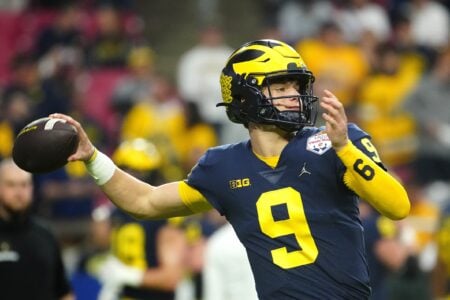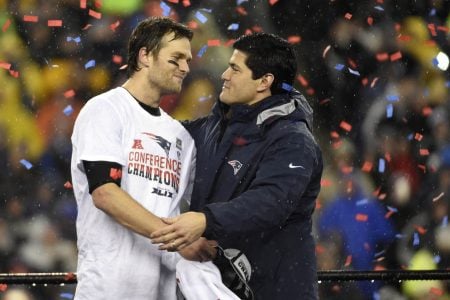- Joined
- Jul 11, 2005
- Messages
- 15,523
- Reaction score
- 27,524
Disclaimer: There have been enough books written on option football to fill a small library. These are thick books with hundreds of pages filled with photographs, diagrams and other assorted visual aids. You will get none of that good stuff from me.  . Instead you will get some meandering observations from an old guy who is at the stage where he has forgotten more than he’s remembered. I’m sure you can google “stopping the read option offense” or “how to run the read option offense” and get a better picture of what the Pats are preparing for. In fact I hope someone who is more comfortable googling for info will do it and post it. We will all be more knowledgeable for it.
. Instead you will get some meandering observations from an old guy who is at the stage where he has forgotten more than he’s remembered. I’m sure you can google “stopping the read option offense” or “how to run the read option offense” and get a better picture of what the Pats are preparing for. In fact I hope someone who is more comfortable googling for info will do it and post it. We will all be more knowledgeable for it.
What I will do is try to give everyone a better idea of the basic concepts of what the offense is trying to do and what the defense does to defend it. My goal is to have you understand better what to look for, and be just a bit more knowledgeable when discussing it. OK…….and we’re off.
FROM THE OFFENSIVE SIDE:
1. The option, in all its various incarnation is a beautiful play. When executed correctly it is virtually impossible to defend. In fact the only real way to defend the option is to make the offense make a mistake. In other words the ONLY way the defense to stop a well run option offense is to consistently make the QB make bad reads or otherwise screw up their execution.
2. The traditional “triple option” was designed to give the QB 3 options that attacked 3 areas of the field. First was a straight dive generally run outside the OG’s outside leg. Second, the QB keeps the ball and continues to stretch the defense taking the ball and attack the outside defender on the LOS. The third option was a trailing RB (the pitch man) which the QB could lateral the ball to. In other words forcing a defender to either attack him or defend the pitch.
3. One of the reasons the offense was so successful was because part of the basic strategy was to leave 2 men on the front 7 completely unblocked. and use those guys gain advantages in other areas. The QB makes his decisions based on how those 2 unblocked men react.
and use those guys gain advantages in other areas. The QB makes his decisions based on how those 2 unblocked men react.
4. For NFL purposes the triple option has been altered. Most of the time it’s hand off to the RB, QB run off the fake, or pass if the LB comes to defend the QB run. Every now and then I‘ve seen a pitch man, but for an NFL skilled QB the pass is the better third option. Now since there is really only one run option, in the NFL version of the read option, usually only one man is left unblocked
5. Now this would be the time were I would show you some X’S and O’s of different blocking schemes, against different defensive alignments and explain some of the possibilities, but we know THAT ain’t happening until Ian finds a way. So let me try to talk you through it.
6. Conceptually the offense wants to dictate a defensive alignment based on their offensive alignment Motion is often used to help the QB determine the coverage pre-snap. . From there a predetermined defensive lineman has designated as the “read”. In a 4-3 it might be the DE. They will not block him and will use that man to get an additional block on a DT or LB to create an advantage. Essentially they want to set up a one on one situation between the RB and DE.
7. The RB will run a tight quick slant right off whatever blocking advantage is created by the extra man, usually right off the OG’s outside leg. Attacking the LOS quickly is key. You want the defense to commit ASAP.
8. At this point the QB makes his mesh with the RB. That means he puts the ball in his pocket. The RB has no idea whether he’s getting the ball. The QB is looking at the DE (in this case). If the DE steps across the line or penetrates the LOS at all, that should create a crease, or at worse a soft spot for the RB and the QB will give the RB the ball. BTW- the mesh point is the most dangerous time for the offense. This is where most of the fumbles occur.
9. However if he steps down the LOS (but not too far) the QB knows that the crease will likely be closed and pulls the ball out and attacks the edge of the defense.
10. Understand the outside players in the offensive formation have released downfield to block or receive and thus softens the edge giving the QB a run option. If the OLB stays to protect against that possibility, it opens up a nice hole for a receiver to be wide open just over the OLB for the QB to dump the ball off. Also much like a play action pass, “read option” teams can also predetermine a pass with more elaborate routes that look like “read option” with the hope of drawing the defense up and throw over them.
11. By now you can see that playing press man against a read option can be a huge problem, because you can simply run off you the very outside defenders who are needed to defend the QB run. That’s why if Seattle is in a formation that they can run “read option” the Pats are going to have to audible out of that coverage.
12. So now let me summarize the problems the “read option” brings. In every area, the play is designed to create 2 on 1 adavantages
A. Use the extra blocker to create a bubble at the point of attack.
B. Force the “read” to play perfect technique. If he’s too aggressive, he’ll create a big crease. If he’s too cautious, he’ll create the kind of soft spot a RB like Lynch turns into a 5 yd gain
C. IF the DE plays it well, now attack the next outside defender with a pass/ run threat. If he attacks too soon the dump off will be there, if he drops, he opens the run lane.
D. When they start to play it perfectly, then use it as your play action pass look and destroy all the defense’s reads. BTW- understand the offense can also change the blocking schemes and who the "read" is, to confuse the D.
13. So hopefully now you can see what it’s such a difficult play to defend. The reality is that the only reason everyone doesn't use it is that NFL quality QB’s are too rare and hard to find to risk running the ball that often Also the more defenses see it, the better they'll get at defending it.
Wilson does a remarkable job in his decision making and avoiding hits. However you can’t avoid them all and we saw the effect of just one solid hit on Wilson by Mathews early in the game. I’m sure THAT was the reason why you didn't see the Seahawks use the “read option” until they absolutely had no other choice.
What I will do is try to give everyone a better idea of the basic concepts of what the offense is trying to do and what the defense does to defend it. My goal is to have you understand better what to look for, and be just a bit more knowledgeable when discussing it. OK…….and we’re off.
FROM THE OFFENSIVE SIDE:
1. The option, in all its various incarnation is a beautiful play. When executed correctly it is virtually impossible to defend. In fact the only real way to defend the option is to make the offense make a mistake. In other words the ONLY way the defense to stop a well run option offense is to consistently make the QB make bad reads or otherwise screw up their execution.
2. The traditional “triple option” was designed to give the QB 3 options that attacked 3 areas of the field. First was a straight dive generally run outside the OG’s outside leg. Second, the QB keeps the ball and continues to stretch the defense taking the ball and attack the outside defender on the LOS. The third option was a trailing RB (the pitch man) which the QB could lateral the ball to. In other words forcing a defender to either attack him or defend the pitch.
3. One of the reasons the offense was so successful was because part of the basic strategy was to leave 2 men on the front 7 completely unblocked.
4. For NFL purposes the triple option has been altered. Most of the time it’s hand off to the RB, QB run off the fake, or pass if the LB comes to defend the QB run. Every now and then I‘ve seen a pitch man, but for an NFL skilled QB the pass is the better third option. Now since there is really only one run option, in the NFL version of the read option, usually only one man is left unblocked
5. Now this would be the time were I would show you some X’S and O’s of different blocking schemes, against different defensive alignments and explain some of the possibilities, but we know THAT ain’t happening until Ian finds a way. So let me try to talk you through it.
6. Conceptually the offense wants to dictate a defensive alignment based on their offensive alignment Motion is often used to help the QB determine the coverage pre-snap. . From there a predetermined defensive lineman has designated as the “read”. In a 4-3 it might be the DE. They will not block him and will use that man to get an additional block on a DT or LB to create an advantage. Essentially they want to set up a one on one situation between the RB and DE.
7. The RB will run a tight quick slant right off whatever blocking advantage is created by the extra man, usually right off the OG’s outside leg. Attacking the LOS quickly is key. You want the defense to commit ASAP.
8. At this point the QB makes his mesh with the RB. That means he puts the ball in his pocket. The RB has no idea whether he’s getting the ball. The QB is looking at the DE (in this case). If the DE steps across the line or penetrates the LOS at all, that should create a crease, or at worse a soft spot for the RB and the QB will give the RB the ball. BTW- the mesh point is the most dangerous time for the offense. This is where most of the fumbles occur.
9. However if he steps down the LOS (but not too far) the QB knows that the crease will likely be closed and pulls the ball out and attacks the edge of the defense.
10. Understand the outside players in the offensive formation have released downfield to block or receive and thus softens the edge giving the QB a run option. If the OLB stays to protect against that possibility, it opens up a nice hole for a receiver to be wide open just over the OLB for the QB to dump the ball off. Also much like a play action pass, “read option” teams can also predetermine a pass with more elaborate routes that look like “read option” with the hope of drawing the defense up and throw over them.
11. By now you can see that playing press man against a read option can be a huge problem, because you can simply run off you the very outside defenders who are needed to defend the QB run. That’s why if Seattle is in a formation that they can run “read option” the Pats are going to have to audible out of that coverage.
12. So now let me summarize the problems the “read option” brings. In every area, the play is designed to create 2 on 1 adavantages
A. Use the extra blocker to create a bubble at the point of attack.
B. Force the “read” to play perfect technique. If he’s too aggressive, he’ll create a big crease. If he’s too cautious, he’ll create the kind of soft spot a RB like Lynch turns into a 5 yd gain
C. IF the DE plays it well, now attack the next outside defender with a pass/ run threat. If he attacks too soon the dump off will be there, if he drops, he opens the run lane.
D. When they start to play it perfectly, then use it as your play action pass look and destroy all the defense’s reads. BTW- understand the offense can also change the blocking schemes and who the "read" is, to confuse the D.
13. So hopefully now you can see what it’s such a difficult play to defend. The reality is that the only reason everyone doesn't use it is that NFL quality QB’s are too rare and hard to find to risk running the ball that often Also the more defenses see it, the better they'll get at defending it.
Wilson does a remarkable job in his decision making and avoiding hits. However you can’t avoid them all and we saw the effect of just one solid hit on Wilson by Mathews early in the game. I’m sure THAT was the reason why you didn't see the Seahawks use the “read option” until they absolutely had no other choice.

















